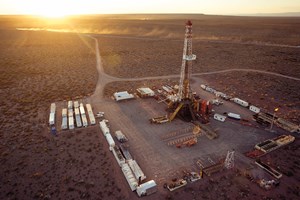Argentina’s Vaca Muerta shale goals move further out of reach
(Bloomberg) --YPF SA, Argentina’s state-run oil company, needs to come up with more than $1 billion to spur drilling in Patagonia, where it’s leading development of the biggest shale patch outside the U.S.
It’s not going to be easy. YPF restructured bonds last week to free up money to spend on shale, which demands a relentless cycle of drilling and fracking. But relatively few creditors took the new notes, and the company could only get $630 million of relief from debt payments over the next two years. It wanted more than that and will have to take extra steps to achieve spending targets, according to a person familiar with the matter.
Cash Crunch
“They really didn’t clean their house as they’d hoped,” said Fernando Valle, an oil analyst for Bloomberg Intelligence in New York. YPF declined to comment.
YPF is aiming for capital expenditures this year of $2.7 billion, which includes $1.3 billion in shale formation Vaca Muerta, as it tries to halt four years of production declines. After the coronavirus pandemic decimated revenue and the debt swap yielded limited results, getting there will require increasing fuel prices, cutting drilling costs, selling local debt, and maybe divesting assets.
At stake is not only the company’s growth strategy, but the future of Vaca Muerta itself as capital controls turn foreign drillers away.
Cheap Fuel
Fuel sales are particularly important because YPF refines most of the oil it produces. Demand for gasoline and diesel has fallen because of the pandemic and prices for them in dollar terms are cheap, too, after years of government meddling to tame inflation.
“If you’re using YPF to subsidize consumers it won’t have capital to keep drilling,” Valle said.
The company needs to raise fuel prices this year by 5% in dollars, issue at least $400 million on the local debt market, and keep lowering costs to reach the $2.7 billion target, said Ezequiel Fernandez, an equity analyst in Buenos Aires for Balanz Capital Valores.
That level of spending would allow YPF to grow crude production by 0.5% this year and keep natural gas production flat. It’s a fine line. Anything less than $2.5 billion would mean another fall in output, Fernandez said.
Shale currently accounts for about a fifth of YPF’s crude. It wants to increase that proportion to a quarter this year and to as much as half by 2023. It produced the equivalent of 468,500 barrels a day of oil and gas in the third quarter of 2020, which is similar to Marathon Oil Corp. in the U.S.
YPF reports fourth-quarter earnings on March 4.



